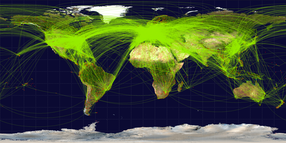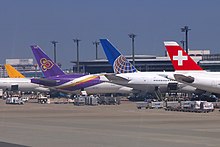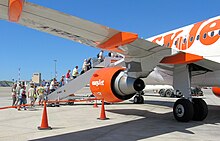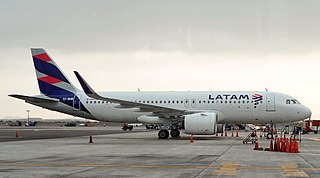
Commercial aviation is the part of civil aviation that involves operating aircraft for remuneration or hire, as opposed to private aviation.

Commercial aviation is the part of civil aviation that involves operating aircraft for remuneration or hire, as opposed to private aviation.
Commercial aviation is not a rigorously defined category. All commercial air transport and aerial work operations are regarded as commercial aviation, as well as some general aviation flights.
An aircraft operation involving the transportation of people, goods, or mail for payment or hiring is referred to as commercial air transport. Both scheduled and unscheduled air transport operations are included. An aircraft used for specialized services including agriculture, construction, photography, surveying, observation and patrol, search and rescue, advertising, etc. is referred to as aerial work.
[1] General aviation includes commercial activities such as flight instruction, aerial work, and corporate and business aviation, as well as non-commercial activities such as recreational flying.
Most commercial aviation activities require at minimum a commercial pilot licence, and some require an airline transport pilot licence (ATPL). In the US, the pilot in command of a scheduled air carriers' aircraft must hold an ATPL. [2] In the UK, pilots must hold an ATPL before they be pilot in command of an aircraft with 9 or more passenger seats. [3]
Not all activities involving pilot remuneration require a commercial pilot licence. For example, in European Union Aviation Safety Agency states [4] and the UK [5] it is possible to become a paid flight instructor with only a private pilot licence. Nonetheless, in the UK, flight instruction is considered a commercial operation. [6]
It is the purpose of the flight, not the aircraft or pilot, that determines whether the flight is commercial or private. [7] For example, if a commercially licensed pilot flies a plane to visit a friend or attend a business meeting, this would be a private flight. Conversely, a private pilot could legally fly a multi-engine complex aircraft carrying passengers for non-commercial purposes (no compensation paid to the pilot, and a pro rata or larger portion of the aircraft operating expenses paid by the pilot).
The magnetosphere guides cosmic ray and solar energetic particles to polar latitudes, while high-energy charged particles enter the mesosphere, stratosphere, and troposphere. These energetic particles at the top of the atmosphere shatter atmospheric atoms and molecules, creating harmful lower-energy particles that penetrate deep into the atmosphere and create measurable radiation. All aircraft flying above 8 km (26,200 feet) altitude are exposed to these particles. The dose exposure is greater in polar regions than in mid-latitude and equatorial regions. When a space weather event causes radiation exposure to exceed the safe level set by aviation authorities, the aircraft's flight path is diverted. [8]
While the most significant — but highly unlikely — health consequences of atmospheric radiation exposure include death from radiation-induced cancer due to long-term exposure, many lifestyle-degrading and career-impacting cancer forms can also occur. [9] [10] A cancer diagnosis can have significant career impact for a commercial pilot. A cancer diagnosis can ground a pilot temporarily or permanently. International guidelines from the International Commission on Radiological Protection (ICRP) have been developed to mitigate this statistical risk. [11] [12] [13] The ICRP recommends effective dose limits of a 5-year average of 20 mSv per year with no more than 50 mSv in a single year for nonpregnant, occupationally exposed persons, and 1 mSv per year for the general public. Radiation dose limits are not engineering limits. In the U.S., they are treated as an upper limit of acceptability and not a regulatory limit. [14]
Measurement of radiation at altitudes above 8 km (26,000 ft) has historically been done by instruments that record the data on board where the data are then processed later on the ground. However, a system of real-time radiation measurement has been developed through the NASA Automated Radiation Measurements for Aerospace Safety (ARMAS) program. [15] ARMAS has flown hundreds of flights since 2013, mostly on research aircraft, and sent the data to the ground through Iridium satellite links. The goal is to assimilate this data into physics-based global radiation models, e.g., NASA's Nowcast of Atmospheric Ionizing Radiation System (NAIRAS), so as to provide the weather of the radiation environment rather than the climatology.
The examples and perspective in this section deal primarily with the United States and do not represent a worldwide view of the subject.(December 2018) |

Harry Bruno and Juan Trippe were early promoters of commercial aviation.
The Air Commerce Act of 1926 began to regularize commercial aviation by establishing standards, facilitation, and promotion. An Aeronautical Branch was established in the Department of Commerce with William P. MacCracken Jr. as director. To promote commercial aviation, he told town fathers that "Communities without airports would be communities without airmail."
Writing for Collier's in 1929, he noted "Commercial aviation is the first industry inspired by hero-worship and built upon heros". He cited the promotion in South America by Herbert Dargue in early 1927. After his 1927 trans-Atlantic flight, Charles Lindbergh made a tour of the contiguous United States, paid for by the Daniel Guggenheim Foundation for the Promotion of Aeronautics. From that point, commercial aviation took off:
Roads were choked on Sundays, for weeks afterward, by motorists trying to get to Lambert Field, Lindbergh's home port in Saint Louis, to buy their first air hop. Hundreds of thousands of you went aloft for the first time that summer. [16]

The Aeronautical Branch was charged with issuing commercial pilot licenses, airworthiness certificates, and with investigating air accidents. [17]

After World War II, commercial aviation grew rapidly, using mostly ex-military aircraft to transport people and cargo. The experience used in designing heavy bombers such as the Boeing B-29 Superfortress and Avro Lancaster could be used for designing heavy commercial aircraft. The Douglas DC-3 also made for easier and longer commercial flights. The first commercial jet airliner to fly was the British de Havilland DH.106 Comet. By 1952, the British state airline British Overseas Airways Corporation had introduced the Comet into scheduled service. While a technical achievement, the plane suffered a series of highly public failures, including the crashing of BOAC Flight 781 and South African Airways Flight 201. [18] [19] By the time the problems were overcome, other jet airliner designs had already taken to the skies.
Inspired by the major players such as the United States, the Soviet Union, Russia, France and Britain in the aviation industry[ clarification needed ]. In the 1910s, Brazil and Argentina were among the first Latin American countries to possess the instruments of aircraft that were not all locally made, yet the aircraft was locally congregated. [20] At that time, many individuals were interested to be pilots in Latin American countries, yet there were not sufficient resources and funding to support and promote the best interests of the aviation industry. [20] Amidst these obstacles, Argentina and the Dominican Republic made efforts in creating jet aviation rather than creating and using propeller planes. [21] In 1944, the Chicago Convention on International Civil Aviation attended by all Latin American countries except Argentina drafted the clauses of aviation law. [22] The introduction of the jet fighter F-80 by the US in 1945 pushed the Latin American countries even further away from development of aviation industry because it was simply expensive to recreate the sophisticated technology of F-80. [20]
The Latin American Civil Aviation Commission (LACAC) was formed in December 1973 "intended to provide civil aviation authorities in the region with an adequate framework for cooperation and coordination of activities related to civil aviation". [23] In 1976, about seven percent of the world logged in the Latin American and Caribbean region. [22] This contributed to the increase of average annual rate of air traffic. [22] Subsequently, higher passenger load factor decided the profitability of these airlines.
According to C. Bogolasky, airline pooling agreements between Latin American airlines contributed to better financial performance of the airlines. The economic problems related to the "airline capacity regulation, regulation of non-scheduled operations, tariff enforcement, high operating costs, passenger and cargo rates." [22]
Corporate social responsibility comprises an umbrella of responsibilities of an organization towards its community, stakeholders and shareholders. [24] Organizations who are socially responsible fulfill their triple bottom line obligations and dedicate efforts to minimize negative impact on stakeholders and shareholders. [24] According to "The Pyramid of Corporate Social Responsibility" by Archie B. Carroll, there are four steps of social responsibility. First, economic responsibility of an organization is to produce profit and maximize the growth of an organization. Second, legal responsibility of an organization is to be compliant with all the laws and regulations. Third, ethical responsibility of an organization to create and follow standards of right decision-making considering how it affects all the stakeholders. Fourth, philanthropic responsibility of an organization to help the community and stakeholders by "giving back". [24] The extent of fulfilling the four responsibilities defines the corporate citizenship of an organization. [24]
Delta and LATAM Airlines were the only two airlines listed on the Dow Jones Sustainability Index, [25] [26] LATAM being the only airline company in the world to achieve 100% scores for efficiency, reliability and climate strategy in their corporate sustainability assessment. [25] LATAM promotes their corporate citizenship in their 2016 Sustainability report. [27] LATAM is affiliated with 6 countries which are Argentina, Colombia, Brazil, Ecuador, Chile, and Peru. [27] LATAM accounts for 95% of South America's air traffic.
Background radiation is a measure of the level of ionizing radiation present in the environment at a particular location which is not due to deliberate introduction of radiation sources.

General aviation (GA) is defined by the International Civil Aviation Organization (ICAO) as all civil aviation aircraft operations except for commercial air transport or aerial work, which is defined as specialized aviation services for other purposes. However, for statistical purposes, ICAO uses a definition of general aviation which includes aerial work.

An aircraft pilot or aviator is a person who controls the flight of an aircraft by operating its directional flight controls. Some other aircrew members, such as navigators or flight engineers, are also considered aviators because they are involved in operating the aircraft's navigation and engine systems. Other aircrew members, such as drone operators, flight attendants, mechanics and ground crew, are not classified as aviators.

The sievert is a unit in the International System of Units (SI) intended to represent the stochastic health risk of ionizing radiation, which is defined as the probability of causing radiation-induced cancer and genetic damage. The sievert is important in dosimetry and radiation protection. It is named after Rolf Maximilian Sievert, a Swedish medical physicist renowned for work on radiation dose measurement and research into the biological effects of radiation.

An aviation accident is defined by the Convention on International Civil Aviation Annex 13 as an occurrence associated with the operation of an aircraft, which takes place from the time any person boards the aircraft with the intention of flight until all such persons have disembarked, and in which (a) a person is fatally or seriously injured, (b) the aircraft sustains significant damage or structural failure, or (c) the aircraft goes missing or becomes completely inaccessible. Annex 13 defines an aviation incident as an occurrence, other than an accident, associated with the operation of an aircraft that affects or could affect the safety of operation.
Ionizing radiation (US) (or ionising radiation [UK]), including nuclear radiation, consists of subatomic particles or electromagnetic waves that have sufficient energy to ionize atoms or molecules by detaching electrons from them. Some particles can travel up to 99% of the speed of light, and the electromagnetic waves are on the high-energy portion of the electromagnetic spectrum.
Korean Air Lines Co., Ltd., operating as Korean Air, is the flag carrier of South Korea and its largest airline based on fleet size, international destinations, and international flights. It is owned by the Hanjin Group.
LATAM Airlines is a Chilean multinational airline based in Santiago and one of the founders of the LATAM Airlines Group, the largest airline holding company in Latin America. Its main hub is Arturo Merino Benítez International Airport in Santiago, with secondary hubs in São Paulo, Lima, Bogotá, Quito, Guayaquil and Asunción.

Radioactive contamination, also called radiological pollution, is the deposition of, or presence of radioactive substances on surfaces or within solids, liquids, or gases, where their presence is unintended or undesirable.
The airline transport pilot license (ATPL), or in the United States of America, an airline transport pilot (ATP) certificate, is the highest level of aircraft pilot certificate.

The European Union Aviation Safety Agency (EASA) is an agency of the European Commission with responsibility for civil aviation safety in the European Union. It carries out certification, regulation and standardisation and also performs investigation and monitoring. It collects and analyses safety data, drafts and advises on safety legislation and co-ordinates with similar organisations in other parts of the world.
Pilot licensing or certification refers to permits for operating aircraft. Flight crew licences are issued by the civil aviation authority of each country, which must establish that the holder has met minimum knowledge and experience before issuing licences. The licence, along with the required class or type rating, allows a pilot to fly aircraft registered in the licence issuing state.
Pilot licensing in the United Kingdom is regulated by the Civil Aviation Authority (CAA).
The International Commission on Radiological Protection (ICRP) is an independent, international, non-governmental organization, with the mission to protect people, animals, and the environment from the harmful effects of ionising radiation. Its recommendations form the basis of radiological protection policy, regulations, guidelines and practice worldwide.

The pilot in command (PIC) of an aircraft is the person aboard an aircraft who is ultimately responsible for its operation and safety during flight. This would be the captain in a typical two- or three-pilot aircrew, or "pilot" if there is only one certificated and qualified pilot at the controls of an aircraft. The PIC must be legally certificated to operate the aircraft for the specific flight and flight conditions, but need not be actually manipulating the controls at any given moment. The PIC is the person legally in charge of the aircraft and its flight safety and operation, and would normally be the primary person liable for an infraction of any flight rule.

Civil aviation is one of two major categories of flying, representing all non-military and non-state aviation, both private and commercial. Most countries in the world are members of the International Civil Aviation Organization and work together to establish common Standards and Recommended Practices for civil aviation through that agency.
The Belgian Civil Aviation Authority is part of the FPS Mobility and Transport in Belgium, directed until 2010 by Secretary of State Etienne Schouppe (CD&V). At this moment, the director-general of the BCAA is Frank Durinckx (a.i.).
The BCAA is responsible for the investigation of Aircraft Accidents and Incidents, Licensing, International and EU Affairs, Quality Services, Company Approvals, Airspace and Airports and Air Navigation Services in Belgium.

Flight-time equivalent dose (FED) is an informal unit of measurement of ionizing radiation exposure. Expressed in units of flight-time, one unit of flight-time is approximately equivalent to the radiological dose received during the same unit of time spent in an airliner at cruising altitude. FED is intended as a general educational unit to enable a better understanding of radiological dose by converting dose typically presented in sieverts into units of time. FED is only meant as an educational exercise and is not a formally adopted dose measurement.

LATAM Airlines Perú Flight 2213 was a scheduled domestic passenger flight in Peru from Lima to Juliaca. On 18 November 2022, the Airbus A320neo was taking off from Jorge Chávez International Airport when it collided with a fire engine that was crossing the runway, killing two firefighters and injuring a third, who died of his injuries seven months later. 40 passengers were injured. The aircraft was damaged beyond repair and written off, making it the first hull loss of the Airbus A320neo family.
A multi-crew pilot licence (MPL) is a pilot licence that permits an aircraft pilot to act as co-pilot of a multi-crew aircraft.